Scooter Nation
Scooters and mopeds are becoming more popular, particularly in bicycle-friendly cities.
I started noticing mopeds when I was in high school and my neighbor got one. I thought it was silly. It was not until college that I realized the convenience and fun mopeds could offer. That’s also when I learned that what looked like a moped was often a scooter. I ended up buying a scooter. I found there are key differences.
Mopeds are more similar to bicycles and scooters are more similar to motorcycles. Mopeds have pedals, bigger wheels, and handlebars. The motor is not as advanced as that of a scooter. For the most part, mopeds have a two-stroke engine, rather than a four-stroke engine, which means the piston moves in one forward and backward motion, compressing the fuel and then refueling. A four-stroke engine, typical of a scooter, is a bit more complicated but also lasts longer. It has a compression stroke and an exhaust stroke. Each of these strokes is followed by a return stroke.
Mopeds do not have the batteries that scooters like mine have. Almost always, mopeds are only 50cc, whereas, scooters can have 150cc. This gives scooters the potential to go much faster than mopeds.
For a college kid like myself, getting a car was out of the question. It was too expensive to purchase, maintain and fill with gas. But for around $2,000, a scooter offered me the same ride and got around 75 miles per gallon. With gas prices at about $3.50 per gallon, these vehicles are economically superior to most cars. This is a key reason scooters are enjoying strong sales both in Milwaukee and nationally.
Before the 1970s, mopeds were virtually non-existent in America. It was not until the oil embargo in the 1970s that gas prices skyrocketed and mopeds became popular in this country. Dealers sold millions of mopeds in that decade.
In the 1970s, Chinese mopeds were the most popular on America’s market. MotoFino, DongFang and many more manufacturers pumped out mopeds and scooters. The price rather than the quality was the main draw. They were the cheapest on the market, averaging around $500, but the typically of poor quality, with continual problems.
They had every kind of problem, says Andy Mauk, co-owner of Moto-Scoot, a Milwaukee scooter shop. “Everything from just valve stems to a tire breaking off or even needing full engine replacements after less than one hundred miles.”
After the poor quality caught up with these companies, most went out of business. But Chinese companies were not the only ones to go under. The poor reputation this gave mopeds hurt other companies like Puch, Motobecane, and Jawa—high quality moped companies that served European riders.
After the burst and bust of mopeds in America, scooters began to take over the market, particularly those made by Honda, Suzuki and Yamaha. These companies made scooters that were more reliable and faster than mopeds. This drove the popularity of scooters past that of mopeds, but scooters were still in the shadows of America’s “bigger and better” culture—which looked down on petite vehicles and celebrated large, fancy cars.
“They were considered for girls,” says Mauk. “It was not considered manly.” But today, larger scooters are available, and the popularity of scooters in Europe has also influenced the U.S., Mauk notes. “We are losing the stigma and people are more and more comfortable riding scooters now.”
On my Genuine Rough House, I can get through traffic easily, ride in the bicycle lane, make easy U-turns and get into some places that cars are not able to go. This is not just convenient; it also makes riding fun.
Parking is also quite easy. Instead of finding a parking spot, I can park my scooter on the sidewalk as long as it does not impede pedestrian traffic. In most states, including Wisconsin, it is legal to park a moped where a bicycle can go. The more bicycle friendly a city is, the more moped- and scooter-friendly it will be.
“Water Street sucks to go down on a bicycle or a moped because of the traffic and because of the potholes,” says Mauk. But other streets are more scooter-friendly.
As with bicycles, a culture is emerging around scooters and mopeds. Two-stroke moped groups ride occasionally around Milwaukee as well as riders with three-speed mopeds. Vintage mopeds are also making a comeback. These mopeds are not the new ones created by well-known companies. They are the classic mopeds that were popular in the mid 1900s. Mopeds made by Puch, Motobecane, and Jawa, are making a comeback.
Dez Trow is moped fan who is part of the Cream City Cranks, a chapter of the Moped Army, a nation wide moped “gang” that celebrates and rides classic mopeds. Ninety percent of moped riders, he says, just see it as a way to get somewhere. But “there’s ten percent of enthusiasts who are passionate about it and it will ruin your life in the best way possible.”
The Cranks get together once a week to ride. They ride around Milwaukee on mopeds, go to rallies around other U.S. cities, and meet and trade mopeds and parts with each other. Their mopeds have rare parts and are usually assembled by the riders.
“It’s fun to do it yourself,” says Paula Heus, a Cream City Crank and an employee at Moto-Scoot. “There is a pride in that. You are not going to really like mopeds, until you hate them first.” At first, it can seem slow and unreliable, until you begin to “really appreciate it,” she notes.
As the moped and scooter worlds start to pick up speed, that’s good news for the dealers. Moto-Scoot hopes to sell 200 scooters this year, and is one of several scooter dealers in town. The scooter culture is growing in Milwaukee.
Moped Dealers in Milwaukee
-Moto-Scoot—1652 N Water St, Milwaukee, WI 53202
-Reina International Auto—Also sells Vespa scooters—715 N Milwaukee St, Milwaukee, WI 53202
-Southeast Sales Milwaukee—6930 N 76th St, Milwaukee, WI 53223
-Motor West Inc.—3211 W Senator Ave, Milwaukee, WI 53216

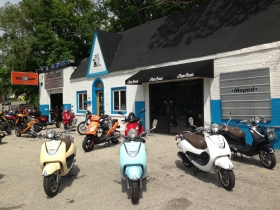
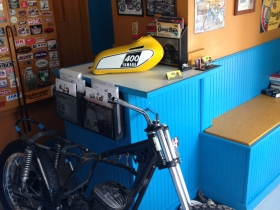
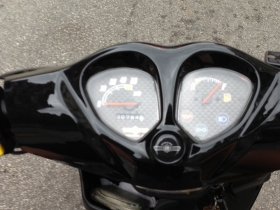
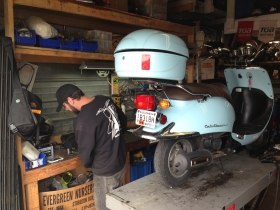
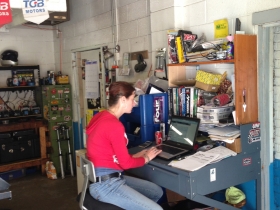




















My Aprilla is 12 years old it has 11000 miles. I prefer to ride my “Piglet”, as opposed to the car, in the city. It’s much easier to park, not to mention cheaper.
I do have issues with the condition of our streets. I have learned where the “holes” are and how to avoid getting thrown off my bike by hitting them head on.
I’v even considered starting a flicker site and asking people to upload pictures and locations of their very natorius pothole locations
Scooters are great, but %*(## mopeds. Especially the old two-stroke engine kinds. They make ear splitting noise and actually pollute more than a hummer. They may look cool but they are vile machines that pollute both lungs and ears. NO NO NO!!!!
More attention should have been given to the classic mopeds and scooters from Vespa and Piaggio, whose style is copied by many of the American manufacturers. The quality is superb (I just upgraded from two to four stroke scooter from Vespa). Andy Mauk should get credit, though, for providing the only service on mopeds and scooters on the East Side. Sometimes he’s overwhelmed by the demand, but he’s always cheerful and works hard to keep people’s machines running.
I have owned a 150cc scooter for 4/5 years. When I bought mine there were very few on the streets. I felt like a true urban rebel. I have put over 3ooo miles on it, primarily city driving. I enjoy the freedom it allows me when the weather is nice. I have not owned a car since 1999. I pay about $2.50 to fill the tank with premium gas and I get about 80-100 miles on it. Moto-Scoot is a great reliable place for tune-ups, oil changes and repairs. I trust them implicitly. I got a puppy last year and he rides with me now. I LOVE my scooter and it is great seeing more of them out there. Cruising the parkways allows you to travel and actually see things as opposed to whizzing by in a car. Parking is easy. I have to agree with the comments about potholes. Milwaukee is horrible but you do find streets like 2nd street to get to the southside and State Street is good to get west. I can travel pretty much anywhere I want to go with scenic routes as long as I plan the time.